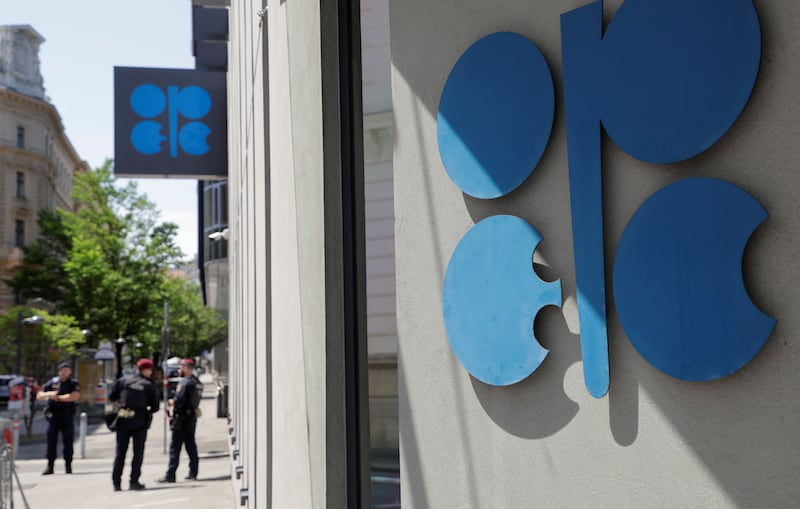The Opec+ alliance of 23 oil-producing countries has agreed to stick to its current output policy, as the group’s production cuts tighten supply and push oil prices higher, the group said after an online meeting of the Joint Ministerial Monitoring Committee on Friday.
The announcement comes a day after Saudi Arabia, the world's largest oil exporter, said it would extend its voluntary oil production cut of one million barrels per day until September.
“The JMMC reviewed the crude oil production data for the months of May and June 2023 and noted the overall conformity for participating Opec and non-Opec countries of the Declaration of Cooperation (DoC),” the committee said in a statement. “The committee urged all participating countries to achieve full conformity and adhere to the compensation mechanism.”
“The committee reaffirmed the commitment of its member countries to the DoC which extends to the end of 2024 as agreed in the 35th Opec and non-Opec Ministerial Meeting on June 4,” it added.
Oil prices recorded their biggest monthly gain since early 2022 in July amid falling crude inventories and Opec+ supply cuts, as cooling inflation eases concerns of aggressive interest rate increases by central banks.
Brent, the benchmark for two thirds of the world's oil, has gained over 15 per cent and WTI by over 18 per cent during the past six weeks. Brent was trading 0.53 per cent higher at $85.58 a barrel at 4.40pm UAE time, while WTI was up by 0.50 per cent at $81.96 a barrel.
Last month, Saudi Arabia said it would extend its unilateral production cut of 1 million barrels per day until August. Meanwhile, Russia is expected to reduce its crude exports by 500,000 bpd this month.
At the Opec+ seminar last month, the Saudi Energy Minister said the group would continue pursuing efforts to stabilise the oil market and will do “whatever is necessary”.
Prince Abdulaziz bin Salman said the market would not be left “unattended” and that the output policy announced on June 4 was “too big for people to comprehend”.
Opec+ has total production cuts in place of 3.66 million bpd, which includes a 2 million bpd reduction agreed on last year as well as voluntary cuts of 1.66 million bpd announced in April.
Futures are seen to be recovering in the second half of the year after macroeconomic concerns and resilient Russian crude supply weighed on market sentiment over the past few months.
Goldman Sachs has reaffirmed its Brent forecast of $86 a barrel by December and expects prices to rise to $93 in the second quarter of 2024. The investment bank also raised its 2023 oil demand estimate by 550,000 bpd.
Swiss lender UBS expects Brent to trade in the range of $85 to $90 a barrel over the coming months and has attributed the recent rise in prices to Opec+’s voluntary output cuts and production interruptions in Mexico, Nigeria and Libya.
Oil demand is projected to breach 103 million bpd in August, driven by higher consumption in China and India, according to the bank.
Lower possibility of a recession in the US and the EU has also improved the crude demand outlook.
US gross domestic product expanded by 2.4 per cent year on year in the second quarter, beating market estimates, according to the Labour Department.
Meanwhile, the US Federal Reserve has indicated that further interest rate increases would be driven by data. Last week, the Fed raised US interest rates by 25 basis points, its 11th increase since March 2022, as part of its efforts to lower inflationary pressure on the nation's economy.
Higher interest rates dampen economic growth, lowering crude demand.
Analysts and economists have raised concerns about slowing economic growth in China, the world’s largest crude importer.
China’s GDP expanded by an annual 6.3 per cent from April to June, after growing by 4.5 per cent in the previous three months, the National Bureau of Statistics said last month.
The pace of growth in the second quarter missed the 7.1 per cent estimate of economists polled by Bloomberg and the 7.3 per cent forecast of those surveyed by Reuters.
Hui Shan, Goldman Sachs Research's chief China economist, expects further monetary easing, but said the massive stimulus employed in previous downturns will not be likely.
“In terms of magnitude, we think it's a moderate amount of easing,” Ms Shan said during a Goldman Sachs Exchanges podcast last week.
“But don't expect too much just given that this year's growth target seems to be within reach and the government is really focusing on transforming, restructuring the economy, [rather] than engineering a short-term sharp increase in growth.”
China is aiming for GDP growth of 5 per cent in 2023, lower than its last year's growth estimate of 5.5 per cent.
The next meeting of the JMMC is scheduled for October 4.






